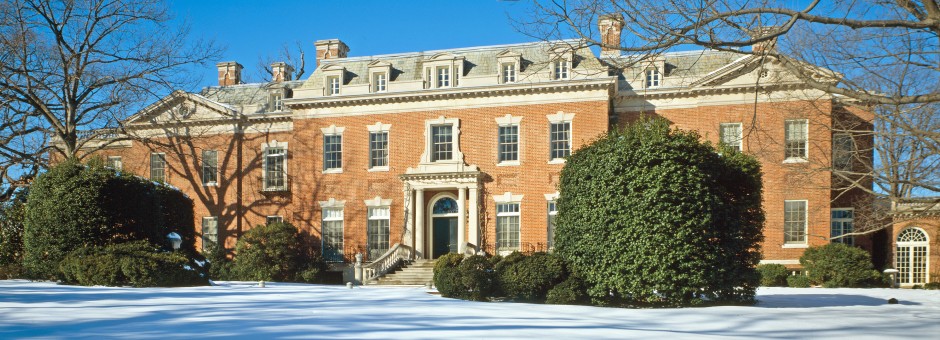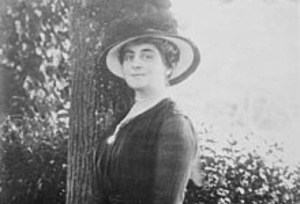Were you to read through all of the transcribed interviews in the Dumbarton Oaks Oral History Project, there is one person in particular who could not fail to fascinate you, yet who is maybe, at last, too ephemeral to apprehend. D.O. Senior Fellow Herbert Kessler thinks that this woman—who underwent what can only be described as a transformative ascendancy—is an ideal subject for a novel, a judgment with which I agree if only because she holds your attention but vanishes in the attending, such that you must half-create what you think you see.
She is Joan Southcote-Aston (1918–1990), who, in Mr. Kessler’s humorous estimation —
started out as a failed Georgetown maid [and] ended up becoming the oracle of the founders of Dumbarton Oaks.
Ms. Southcote-Aston worked at D.O. for 31 years, beginning in 1958, and had official titles, to be sure — secretary or research assistant under Director of Byzantine Studies Ernst Kitzinger, Curator of the Princeton Index, Special Assistant to the House Collection, and so on. She also was nothing less than a magnifico of the Dumbarton Oaks Friends of Music concert series and, under Giles Constable’s democratic directorship, she was “in some ways running Dumbarton Oaks,” as Mr. Kessler puts it. Indeed, Constable fondly remembers her in his oral history interview and remarks —
Not everybody liked her! And I could never understand why. I think she was a very remarkable person…. Joan did the music, and thank god, I felt at the time, there was a job for her. Because, otherwise, in the new Dumbarton Oaks, she wasn’t a scholar, she was more of the old tradition of a Bliss retainer.
Garden design historian William Howard Adams echoes Constable’s words —
She was in a funny way sort of misplaced there; she wasn’t a scholar, and I wasn’t sure what her role really was.
A Briton by birth, Ms. Southcote-Aston moved to the United States during World War II. The oral history record, however, is curiously divided: did the young immigrant “work in the British Embassy,” as Assistant Librarian Caroline Backlund has it (who adds, “I think she was one of those lovely ladies that was hired, but she wasn’t really a professional”)? or was she “a housemaid to J. P. Morgan’s daughter, who lived in Georgetown,” in Herb Kessler’s words?
- J.P. Morgan’s daughter, Anna Morgan
Ms. Backlund tells us that Joan Southcote-Aston landed a job at Dumbarton Oaks as follows —
She was a friend of Mr. Thacher’s—met him at some embassy thing—and so they hired her. She really had no professional background, but she could translate and she was very good at what she did, but she was very fragile.
In contrast, Herb Kessler recounts —
What I was told was she had in fact come to the States as a housemaid to J. P. Morgan’s daughter, who lived in Georgetown, and was found unsatisfactory. So, Ms. Morgan, whatever her name was, called Mildred Bliss and said, ‘Can you help me out? I don’t want to have to send her back.’ So Mrs. Bliss hired her.
Her obituary in the Washington Post asserts that she was a social secretary at the British Embassy in Washington, D.C. and that that was where she met the Blisses. Whatever the case, all interviewees agree that what Ms. Southcote-Aston lacked in training and skills as related to Dumbarton Oaks activities, she compensated for with “loveliness,” a word that seems to orbit around Ms. Southcote-Aston’s name like the astonished mirroring Moon around Earth. Giles Constable admits referring to her and Irene Vaslef and Jelisaveta “Seka” Allen as the Three Graces —
And they knew it…. And we loved them dearly. And they were very traditional D.O.ers, and they were, as far as I know, absolutely supportive of us.
Could it be then that her true role at Dumbarton Oaks was maintaining its traditions in decorous harmony? Again, Herb Kessler explains —
She had the living memory—she could and did say, ‘Well, Mrs. Bliss would not have approved of that, Mrs. Bliss would have not allowed Fellows to come to concerts without ties.’ That was probably true—so, one listened to her.
Indeed, based on observations like this, Joan Southcote-Aston had a pinchingly acute sense of decorum — a sense that extended from guardian of the dress code to latch-key oracle. Ms. Southcote-Aston made it her duty to right crookedness and banish unloveliness in the cultivated environment of Dumbarton Oaks, and in this sense she had nothing less than metaphysical centrality. “She was, at one point,” Ms. Backlund recalls —
in charge of all the objects in the museum — so that [if] things need reupholstered or if the pictures weren’t hung straight.
And without at the time being able to remember her name, Gary Vikan amusingly recounts his first encounter with Dumbarton Oaks’s surrogate doyenne —
I did have a little teeny run-in with somebody who I grew to like very much whose name escapes me – she was a very wispy, older woman who ran sort of the downstairs photo archives and a few other things like that. She was kind of a hanger-on from the time it was more family-like and less kind of corporate, and I can’t remember her name, but she had diabetes. And everyday she would feed the lion, which meant to say, she would eat lunch early, because of her diabetes. She had to go feed the lion! … I remember using the Christian Index; I don’t know if you know where that is down there, and I was wearing jeans or something. No, I’d gone to the music thing on Monday night, where Alexander Schneider and all these guys used to come there, and she called me in my little cubicle at the National Gallery and said that I’d dressed inappropriately! I had worn jeans to this thing, and I thought, ‘My God! They are invading my life. I didn’t get a fellowship, and now they are telling me how to dress!’ What was her name? I forget, but I grew to like her very much. I can’t remember her name.








[…] D.O. miscellany, from the goofy (Fletcher’s Castoria, anyone?) to the primly sublime (meet Ms. Joan Southcote-Aston!). We hope the blog both sparks new interests in its readers and renews respect for D.O.’s […]
[…] and also provided us with an affectionate sketch of D.O.’s oracular Joan Southcote-Aston (https://doakshistory.wordpress.com/2013/07/02/ms-joan-southcote-aston/). Director of Gardens and Grounds Gail Griffin, soft-spoken and deeply kind, took us beneath the […]